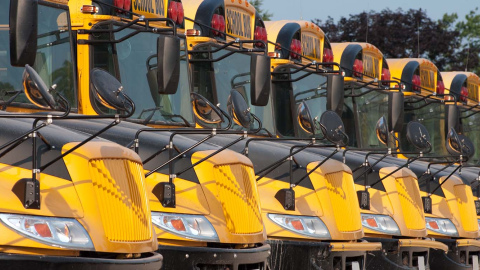

Climate change has already begun to transform the way human beings live and work, but the beginning of this past school year was a devastating reminder of the impact a warming planet will have on education. Extreme weather damage, from Hurricane Ida in Louisiana to wildfires in California, resulted in school closures affecting more than 1.1 million students, and this existential threat will only continue to grow worse for generations of students.
Harvard Graduate School of Education lecturer Laura Schifter is a senior fellow at the Aspen Institute where she founded K12 Climate Action, a new initiative that is working to unlock the potential of the education sector to enact solutions to help in the fight against climate change. And with its big carbon footprint, those solutions begin in schools themselves. As Schifter says, people tend to forget just how large a sector education is in the United States, with nearly 100,000 public K–12 schools occupying 2 million acres of land and producing 53,000 tons of food waste. Schools also operate one of the largest mass transportation fleets in the country with 480,000 school buses and are one of the largest public energy consumers.
“It’s going to be up to everyone to figure out how to contribute, and the education sector has to come together to address climate change,” she says.
Drawing together a bipartisan commission comprising education and environmental leaders including former Obama Administration Secretary of Education John King Jr., former Bush Administration EPA administrator Christine Todd Whitman, and the presidents of the two largest teachers’ unions in the United States, the group recently released their K12 Climate Action Plan. Combining a year’s worth of listening tours and research, the report offers actionable climate solutions at various levels, including steps that schools can take to become more sustainable.
Schools are one of the largest public sector consumers of energy, producing the equivalent of 18 coal-fired power plants or 15 million cars each year. That usage is also the second-largest source of expenses for districts. Schools have the power to help lower greenhouse gas emissions while also lowing costs: They can reduce energy usage through renewable sources like geothermal heating and cooling, LED lighting, and solar energy.
“Think about the economic advantages. If you’re producing your own energy, that’s huge and should be available to all schools,” Schifter says.
At the Batesville School District in Arkansas, the 1,482 solar panels they installed on two schools now generate half the district’s energy needs, saving nearly $100,000 per year in costs. Those savings have since gone to raise teaching salaries. The district has also invested in teacher training to incorporate solar technology into STEM classes.
Today, nearly 94% of school buses are diesel powered, creating air pollution that harms not only the climate but also student health. By switching to buses that run on electricity, districts can help create cleaner air while also saving an average of $170,000 in maintenance and operation costs over the lifetime of a single electric bus.
While the upfront costs can be high, public-private partnerships, grants, and government support can significantly reduce costs for districts. That’s what the Stockton Unified School District in California did through grants from the California Air Resources Board, the California Energy Commission, and rebates from their local utility company.
“You talk about the supply side and the demand side. Climate folks think about the supply side, but if the education sector is advocating, they are advocating on the demand side,” Schifter says, adding that the call from schools for new technology like solar panels and electric buses can accelerate change.
“If you’re not using gas, you’re going to have better indoor air quality, and if you have a green schoolyard, you’ll have lower temperatures than a school surrounded by asphalt,” Schifter says. “Building climate resilient schools is going to be central to student health and learning outcomes.”
But the transition to more sustainable schools won’t just be a benefit for students. Schools have the opportunity to be centers of resilience and support for their communities in the face of climate change, in particular for communities of color and low-income areas that have been disproportionally affected by deadly weather.
Schifter points to the Pacific Northwest this past summer, where a heatwave killed hundreds of individuals, in particular those without access to green space or air conditioning. Schools that switch to renewable energy like solar and utilize battery storage technology can remain operating in the face of climate disasters, offering critical resources like shelter, electricity, and healthcare for students, families, and entire communities.